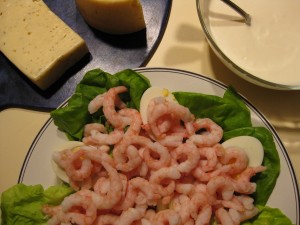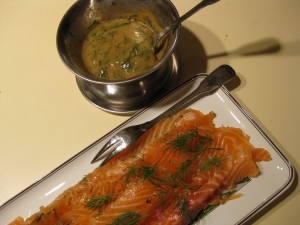One more food post for Swedish Christmas Eve. It’s a very ritualized meal in our family. We don’t do the traditional ham. Instead, we eat a smogasbord, one dish at a time in a specific order. We begin with cold herring and small boiled potatoes, and then move to the gravad lax and then the shrimp and egg. The last fish dish is Jannson’s frestelse — a shoestring scalloped potato dish with Swedish anchovies, which are sweet, juicy, and spicy, not so salty. Then we eat small meatballs with no sauce but a bit of broth and ham and cheese and hardbread. And we sing and drink snapps, and finish with rice pudding and Christmas cookies. It is a simplified version of the one we used to do, because we have a lot of people in our house who just don’t like herring all that much. So no more sillsalad and matjes herring. And no more braised mushrooms and kidneys (thank goodness) or eel and scrambled egg, which was my Czech Jewish grandfather’s favourite. I haven’t told anyone, but I think I might make fagelbo this year. If I do, photo and recipe next December, because it is very pretty.
This is one of the easiest dishes we make and it is easily multiplied for a bigger crowd, or shrunk just for one or two. You will need:
- 4 hardboiled eggs, peeled halved lengthwise
- 1 1/2 c cooked peeled baby shrimp, the kind you get frozen in a big bag
- 1 boston lettuce
Line a plate with lettuce leaves. Spread the hardboiled eggs on it in one layer. Layer the thawed shrimp evenly over the eggs. Then top with the following dressing, made of all these ingredients, mixed together:
- 1/4 c whipped cream
- 1/4 c good mayonnaise. I was not much of a “brand” person until I bought some Whole Foods mayonnaise. *Shudders at the memory* I suggest Hellman’s. You can also replace some of the cream and mayonnaise with good yoghurt.
- 1 tbs. chopped dill. If you don’t like dill, this whole Swedish Christmas Eve thing may not be for you. Just saying.
- 1/2 tsp. salt
- dash white pepper
Here’s what it looks like before you add the dressing. You can see the dressing to one side, and also some cheese on a wooden board. God Jul!



